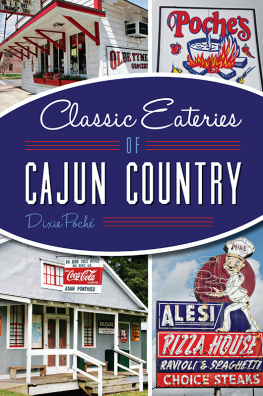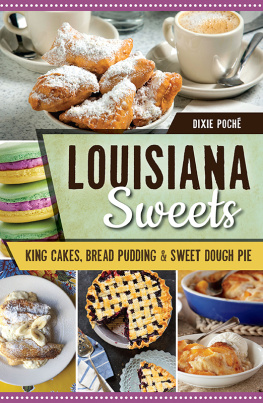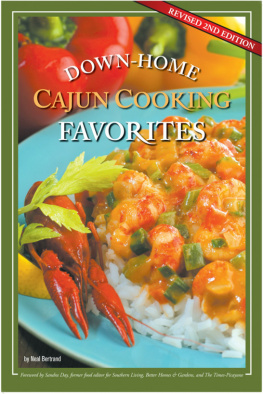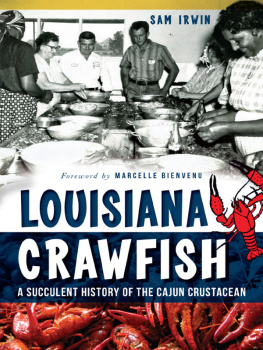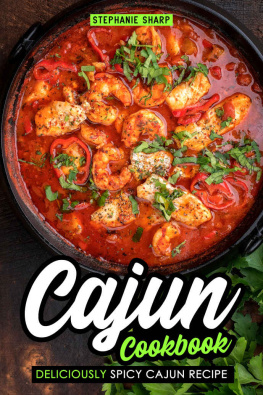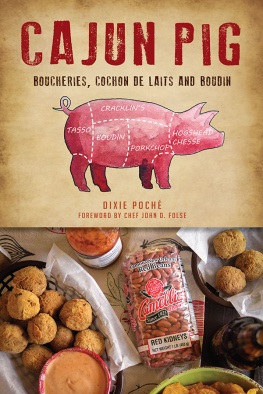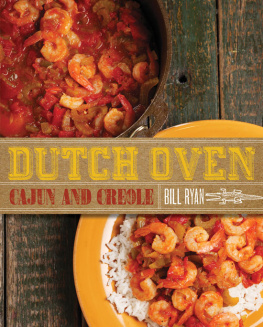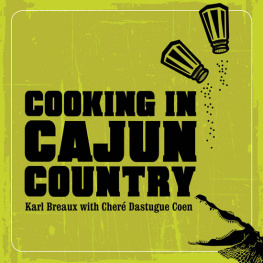

Published by American Palate
A Division of The History Press
Charleston, SC 29403
www.historypress.net
Copyright 2015 by Dixie Poch
All rights reserved
First published 2015
e-book edition 2015
ISBN 978.1.62585.345.5
Library of Congress Control Number: 2015944405
print edition ISBN 978.1.62619.808.1
Notice: The information in this book is true and complete to the best of our knowledge. It is offered without guarantee on the part of the author or The History Press. The author and The History Press disclaim all liability in connection with the use of this book.
All rights reserved. No part of this book may be reproduced or transmitted in any form whatsoever without prior written permission from the publisher except in the case of brief quotations embodied in critical articles and reviews.
It all started at the fais-do-do at the Rendezvous Club. In appreciation to my parents, Jesse and Genevieve Huval.
CONTENTS
ACKNOWLEDGEMENTS
Showman P.T. Barnum once said, There is much to be learned in a country store. Out of despair, Barnums father opened a dry goods store in a New England hamlet, hoping to shape his son into a merchant. As a young clerk in a rural country store, Barnum fine-tuned his verbal skills and powers of trading in dealing with customers. His gift of gab served him well later in life as he perfected an entertaining personality. Valuable experiences behind the store counter, bargaining all the while, guided him through remarkable careers as a newspaper editor, museum director, lottery agent and, most famously, as a circus showman. Although he complained of many dull times during wet days at the shop, he paid close attention to the wit and wisdom of the people he met, honing his skills to become known as the Prince of Humbugs, one of the founders of the Greatest Show on Earth, the Barnum & Bailey Circus.
My fun-loving experiences in a family country store while growing up piqued my interest to write about the hardworking men and women in old-time grocery stores, cafs and bakeries in the parishes of Acadiana, also called Cajun Country. There are many of these mom and pop businesses, so popular for their nostalgic appeal as a welcome respite from the big box stores. What seemed to be a common thread was the dedication of the veterans behind the counter or in the kitchen, as well as the pure guts they displayed over the generations.
I am grateful for the assistance from all the librarians and visitors centers along the way, directing me to research material and introducing me to a foodies paradise. Ah, how I was enticed by the delights of everything from plump boudin links to crispy French bread, crawfish served every which way, king cake and bread pudding to please my sweet tooth, lusty oyster poor boys (po-boys), rice and gravy and boiled crabs. As much as I love sampling the riches of Cajun cuisine, I admit that I did pass on the marinated beef tongueI just couldnt do it! Thanks go out to all of the merchants for sharing their inspirational stories with me.
Introduction
JAMBALAYA, CRAWFISH PIE AND FIL GUMBO
What is the worlds fascination with the Cajun culture? Is it the mumbo-jumbo of spices in so many of the dishes that tantalize us? Lively music of accordion and fiddle? The hint of a French accent?
The joie de vivre (joy of living) through many festivals and hospitality play a large part in explaining why Louisiana has the five happiest cities in America. In 2014, a report from Harvard examined the happiness of cities, concluding that the five happiest cities in America are located in one state: the Pelican State of Louisiana. The cities were Lafayette, Houma, Shreveport-Bossier City, Baton Rouge and Alexandria. Lafayette took the crown as the Happiest City in the U.S.
The Cajun people are descended from the Acadians who were exiled from Nova Scotia for political reasons in the mid-1700s. In refusing to take an oath of allegiance to the British, the mostly French-speaking Catholic Acadians faced tremendous hardships. Groups of families were separated through deportation. Thousands relocated to southern Louisiana, where they adapted to the bayous, swamps and prairies. While the Acadians learned to thrive in their new surroundings, they developed a cuisine, intermingling influences from other cultures within Louisiana: Spanish, German, Italian, Creole, Native American, African and French. Ever resourceful, the Acadians used their ancestral recipes while also introducing the fruits of their new terrain. They grew crops on fertile land along the bayous, hunted, fished and gathered herbs. The term Cajun is derived from Acadian.

John F. Kennedy during his presidential campaign as he toured Louisiana. Shown with Louisiana Maids and Louisiana senator Dudley LeBlanc, who developed Hadacol. Courtesy of Lafayette Parish clerk of court Louis J. Perret.
National attention was brought to some of the more popular Louisiana dishes through Hank Williamss 1952 song Jambalaya (on the Bayou), which praises the dishes of jambalaya, crawfish pie, and fil gumbo. When the lighthearted song hit the top of music charts, Americans became enamored of the Cajun culture and its tongue-tingling cuisine. As a son of the South, Hank Williams, born near Montgomery, Alabama, had a fond relationship with Louisiana because of the seemingly carefree lives of the Cajuns. He co-wrote the lyrics to the song while enjoying the one-pot wonder of jambalaya in New Orleans. Hank traveled throughout Louisiana, performing in many schoolhouses and honky-tonks. His Cajun fans were glued to the radio on Saturday nights to hear Hank perform from Shreveport, Louisianas Louisiana Hayride. Hank also headlined a promotional tour of the Hadacol Caravan, journeying by train throughout Louisiana and much of America. The tour of the feel-good concoction of 12 percent alcohol, Hadacol, originated in Lafayette.
Understanding the Cajun culture begins with a peek into the kitchen, with images conjured up of a black-iron pot, big spoons for stirring, onions, bell peppers, celery, garlic, other seasonings and a rice cooker. Recalling the aroma and taste of the comfort food of gumbo on the stove transports us back to Maw-Maws kitchen. Much of Cajun cuisine stems from a custom of slow cooking, often bolstered by cayenne pepper to uncover mouthwatering dishes for the community at large. The rituals of celebratory gatherings acted as a springboard to launch businesses in the food industry such as restaurants, grocery stores and bakeries. Beginning with preparing special dishes for the family in the home kitchen or at hunting camps, entrepreneurs were often inspired by these gatherings to try business startups.

Train caravan promoting the tonic Hadacol in downtown Lafayette. Courtesy of Lafayette Parish clerk of court Louis J. Perret.
- BOUCHERIESSlaughtering of a pig, usually held in late fall or winter. It takes a full day to slaughter, prepare, cook and share every part of the pig (everything but the squeal)such as sausage, boudin, crackling and hogshead cheese. The day after a boucherie was often dedicated to making soap for the family by cooking down leftover pig lard and lye. Perfume and bits of old soap were tossed in for scent.
Next page
